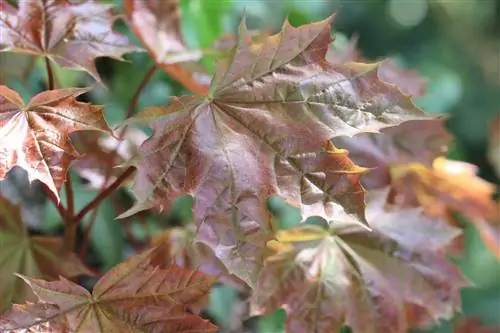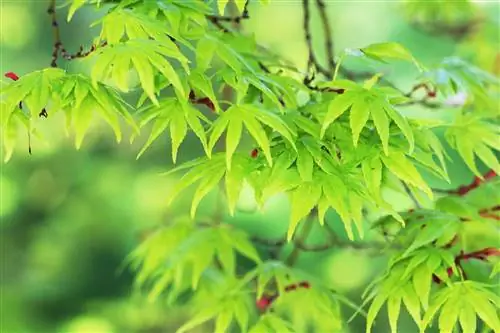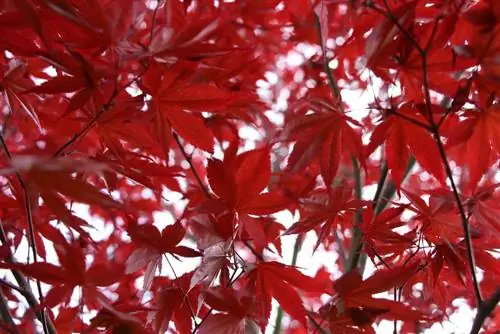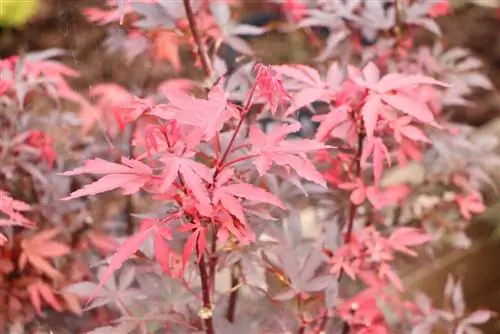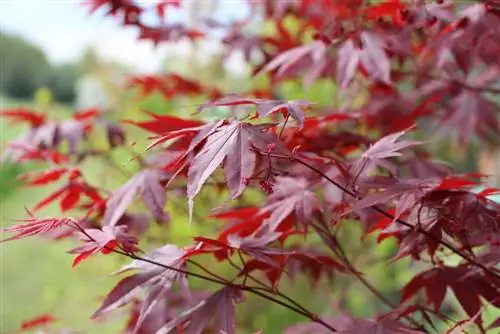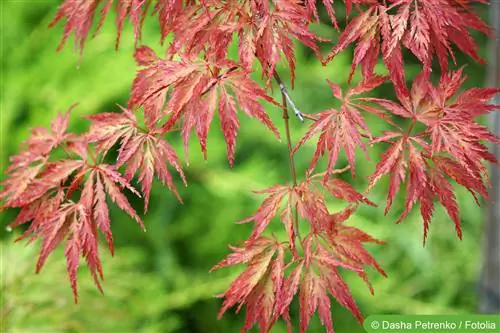- Author admin [email protected].
- Public 2023-12-17 03:39.
- Last modified 2025-01-24 12:45.
At home in all good garden soils, the Norway maple offers the security of a tried and tested deciduous tree. A dense, spreading crown unfolds over a slender trunk. In early spring, a decorative, yellow flower shines before the leaves emerge. Frost doesn't bother an Acer platanoides, nor do summer heat periods.
If you give it a free hand in its growth, it will easily reach a height of 20 meters or more. You can find out what other advantages the popular tree has and how to care for it here:
Profile
- Genus of maples (Acer)
- Name of the species: Norway maple (Acer platanoides)
- Deciduous, hardy down to -32 °C
- Typical leaf shape 5-7 lobed, tapering
- Slender trunk with a diameter of 60-100 cm
- Yellow flower umbels from April to May before the leaves emerge
- Growth height after 10 years up to 4 meters
- Final dimensions between 20 and 30 meters
- Winged split fruits from October
- Major use: ornamental tree in gardens and parks, avenue tree
The Norway maple is widespread in Europe. Here it thrives primarily on the extensive plains. He rarely climbs the mountains up to a maximum of 1,000 meters.
Location
The Norway maple develops a very shallow heart root system, which is characterized by a high proportion of fine roots. This characteristic means that the tree allows virtually no underplanting. Otherwise, the popular deciduous tree shows a good-natured location tolerance. It develops its optimum under the following conditions:
- sunny to semi-shady location
- fresh to moist soil, preferably sandy-loamy or sandy-clayey
- nutrient-rich, humic and warm
- ideally a pH value of 4.2 to 7.8
- excellent urban climate compatible
Compacted, oxygen-poor soil is either completely avoided as a planting site or cultivated accordingly. Moor and peat soils have no chance of being accepted as a location. The Acer platanoides has no objection to a calcareous and sometimes dry soil condition.
Pouring
When a Norway maple is young, it is watered regularly. Once it has become well established at the location, it is supplied with sufficient water by its extensive root system. Only when the summer is dry should you water the tree thoroughly without causing waterlogging. Since Acer platanoides prefers slightly acidic soil, watering with rainwater is recommended. This is especially true if the deciduous tree is initially cultivated in a container. In the limited space of the planter, a continuous water supply is advisable so that the root ball does not dry out completely.
Tip:
A thick layer of mulch made of leaves, grass clippings or compost reduces the evaporation of irrigation water and contributes to the supply of nutrients.
Fertilize
Additional nutrients make a valuable contribution to ensuring that the Norway maple develops its beautiful leaves and produces decorative flowers. This applies in the pot as well as in the bed.
- Starting fertilization in March with compost or slow-release fertilizer gets the flowering going
- Incorporate compost into the bed every month during the vegetation phase
- Administer liquid fertilizer in the bucket every 4 weeks from March to August
Apart from compost, other organic fertilizers can also be considered, such as guano, nettle manure or manure. Investing in special mineral fertilizers is under no circumstances necessary.
Cutting
A Norway maple is reluctant to get to know garden shears. In general, pruning is not necessary anyway as the tree naturally develops its shapely habit. In addition, there is plenty of milky juice flowing in his veins. If such a tree is cut in the middle of the growing season, there is a risk that it will 'bleed'. As a result, entire branches or the entire tree die. If a topiary cannot be avoided, it is carried out while the sap is dormant in late autumn or in January/February. Here's how to do it:
- ideal is a frost-free day with overcast, dry weather
- the cutting tool is freshly sharpened and meticulously disinfected
- Cut off dead wood without leaving stubs
- Short shoots by a maximum of a third of their length
- place the scissors at an angle, just above a bud
Cut wounds are sealed with charcoal ash or a thin layer of tree wax. Due to the high sap content, a Norway maple is susceptible to infestation by fungi, bacteria or pests. Even small wounds should not be left open.
Diseases
Although the environmental pollution in the urban climate does not affect a Norway maple, it is not completely immune to diseases. The following are the most common plagues that can affect deciduous trees:
Powdery mildew
It hurts the hobby gardener's soul when the beautiful maple leaves are covered with a milky-white patina; Fortunately, the fungal spores do not cause permanent damage. There is therefore no need to resort to aggressive fungicides. The following countermeasures are recommended:
- Don't leave the autumn leaves lying there, burn them instead.
- Spray the tree every 3 days with a milk-rainwater solution in a ratio of 1:2.
- Alternatively, apply primary rock powder to dewy leaves every 2-3 days using the powder syringe.
If you suspect that your Acer platanoides is at risk from powdery mildew, strengthen the tree with liverwort extract from February/March. In addition, nitrogen-based fertilization should be avoided.
Maple wrinkled scab
This fungal infection is also called tar spot disease in reference to the typical symptoms. There are numerous black spots on the leaves, surrounded by a yellow border. This is the early stage of the disease, so there is still time to fight the disease. Only in the following year will the dreaded black fungal patches spread further as a second stage. It is therefore advisable to remove and burn all leaves in autumn. This means you deprive the maple scab of any chance of spreading further.
Verticillium wilt (Verticillium alboatrum)
If the Norway maple leaves its leaves hanging limply even though it is watered regularly, it is most likely suffering from a harmful fungus that is blocking the water pipes inside. Typically, only the older leaves initially indicate damage, while the young leaves still appear he althy. Under real drought stress, the entire foliage would be affected. Since there is currently a lack of effective control agents, the only option in the event of an infestation is complete clearing, including the root system. The following measures have proven to be effective as a preventive measure:
- Do not plant Norway maple in wet, compacted soil.
- Avoid any injury to the roots.
- Carry out root ventilation every 3 to 4 years.
- Always carry out cutting operations with disinfected tools.
- Fertilize preferably organically with compost.
Conclusion of the editors
The Norway maple is a grateful deciduous tree that provides a decorative appearance in every garden. It is the combination of appealing attributes that makes it so popular. The mighty crown, densely covered with the typical maple leaves, is just as much a part of it as the pretty flowers in early spring. Thanks to its undemanding care and high location tolerance, an Acer platanoides is recommended as the ideal house tree for the hobby gardener.
What you should know about Norway maple in brief
- The Norway maple is also called the pointed-leaved maple because it has very long, pointed leaves.
- The native tree is widespread. It is particularly noticeable at the beginning of spring due to its many yellow-green flower umbels.
- The Norway maple is deciduous and of average height.
- A specimen can be 20 to 30 meters high and around 150 years old.
- Norway maple trees usually have an egg-shaped crown and a slender, straight trunk.
- Since it also thrives in partial shade, the Norway maple is very versatile. It is often found in silviculture.
- His wood is in great demand. It is very resistant to tension and compression.
- Since the Norway maple is very resistant to industrial stress, it is often used for greening in urban areas.
- Red-leaved varieties are particularly popular. Ornamental shapes are also often used for parks. Norway maple avenues are also common.
- The Norway maple thrives on deep, moist, nutrient and alkaline-rich clay and stone rubble soils.
Flowers
- The flowers are in upright clusters.
- You can find both hermaphrodite and unisexual female and male inflorescences.
- In many cases the sexes are distributed among different individuals.
- The gender distribution is incompletely dioecious. The flowers are yellowish-green.
- The flowering period begins in April and ends in May.
- The Norway maple blooms when no leaves have yet sprouted on the tree. The flowers are pollinated by insects.
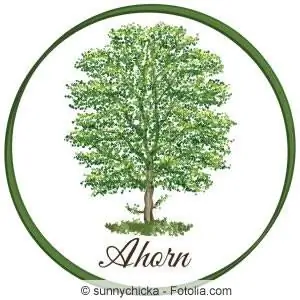
Fruits
- The fruits of the Norway maple are small nuts. They are winged in pairs.
- The wings are obtuse-angled to horizontal.
- The fruit is called a split fruit because the ovary splits when ripe.
- The partial fruits are flat, with a barely curved fruit shell that is also bare on the inside.
- The fruits are spread by the wind and so the trees multiply.
leaves
- The leaves of the Norway maple are palmate. They have five to seven lobes, like fingers on a hand. These are long pointed.
- The leaves are entire leaf lobes. The bays between the lobes are always blunt.
- If the leaves or even the young branches are injured, milky sap will come out.
- The top of the leaves is slightly shiny. The underside is usually lighter than the upper side and only slightly hairy on the leaf veins.
- The petiole is 3 to 20 cm long and spherically thickened at the base.
- There are Norway maples with green and red leaves. The leaf color is particularly interesting in autumn: from yellow to bright orange.
Bark
- The bark of the Norway maple is smooth and pale brown when young.
- The older the tree gets, the darker the bark becomes. It can be brown, but also gray.
- The structure is longitudinally cracked and not flaky.
- The trunk can be 60 to 100 cm thick.
Other
- Norway maple trees often suffer from a type of powdery mildew. It is powdery mildew, caused by infestation with Uncinula talasnei.
- The disease is particularly common in Norway maples in urban areas, but is harmless to the trees. It just doesn't look pretty.
- Tar spot disease and maple scab also occur.

